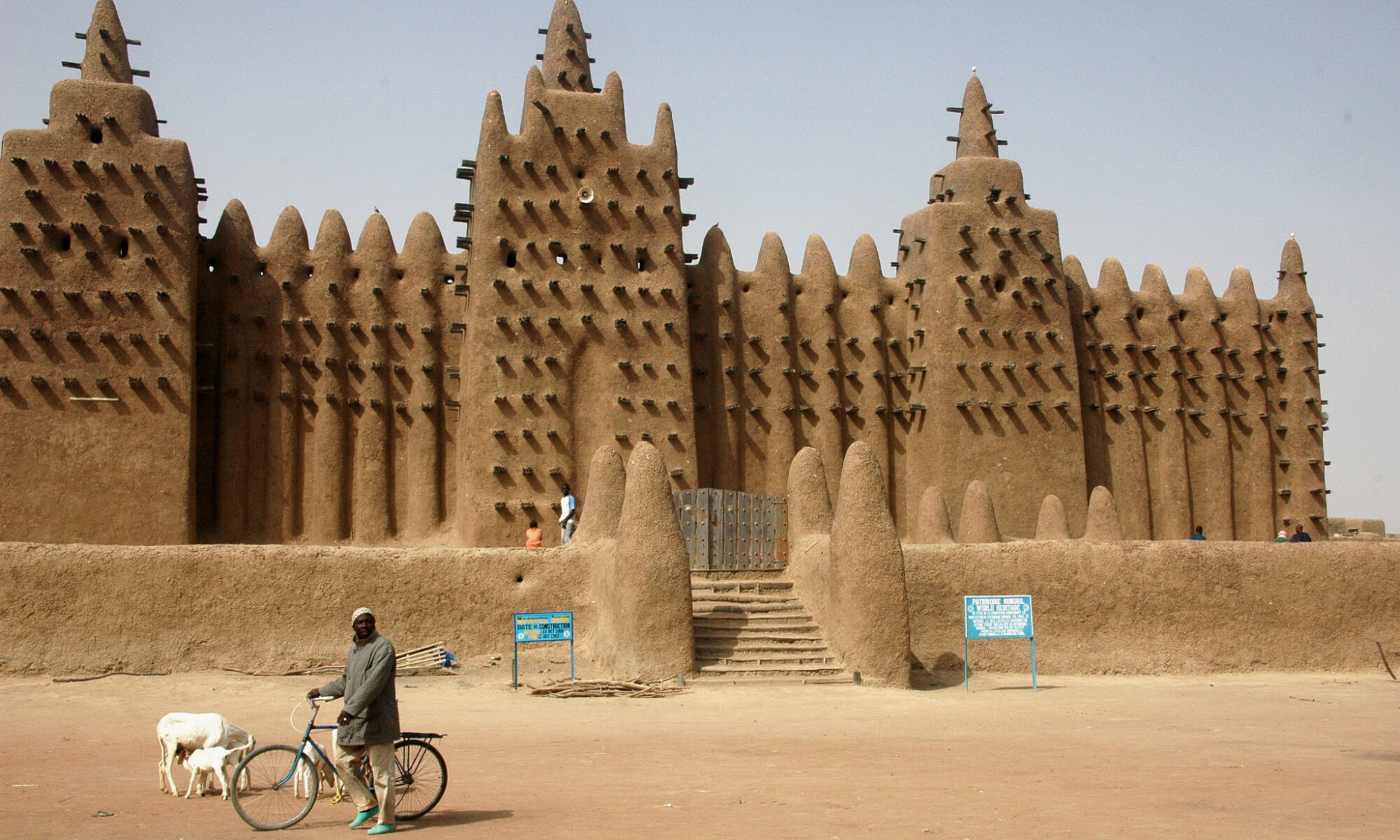Shibam
World’s Oldest Mural is on a Mud Brick Wall
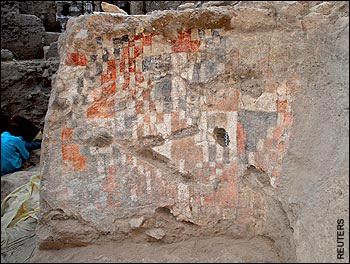
French archaeologists have discovered an 11,000-year-old work of art in northern Syria which is the oldest known wall painting, even though it looks like a work by a modernist. Rectangles dominate the ancient painting, which formed part of an adobe circular wall of a large mud brick house with a wooden roof. The dating makes the designs at least 1500 years older than wall paintings at Çatalhöyük, the famous 9500-year-old Turkish village, among one of the first towns.
Shibam
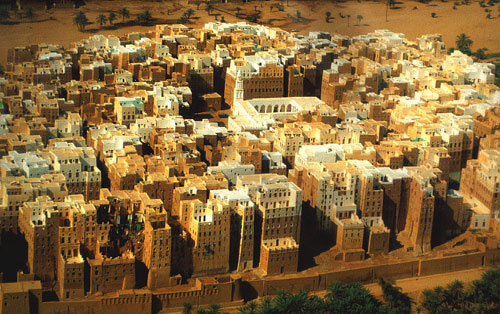
Shibam, Yemen, also known as ‘the manhattan of the desert’, is home to the world’s oldest surviving skyscrapers.
Shunet el-Zebib
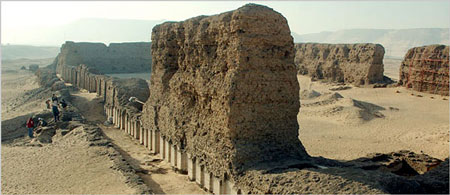
photo: Institute of Fine Arts, N.Y.U./American Research Center in Egypt
Before the great pyramids, ancient Egyptian kings left less grandiose monuments to themselves: fortresslike sanctuaries enclosed by mud-brick walls. Inside these mortuary complexes, people presumably gathered to worship and perpetuate the memory of their departed ruler. The crumbling, almost vanished remains of such structures, archaeologists say, attest to the political hierarchy and religion of the newly unified Egyptian state, beginning more than 5,000 years ago.
Saddam Hussein: 1937-2006
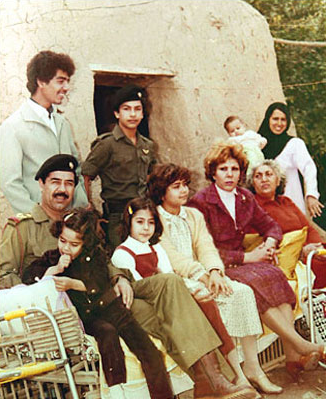
Saddam Hussein was born in a mud brick house to a family of sheep-herders in Tikrit, Iraq on April 28, 1937. He grew up in the town of Al Dawr, a mud brick town on the banks of the Tigris River.
Iraq is home to some of the most enduring wonders built in mud from the ancient world include the Ziggurat at Ur and the Ctesiphon Arch, the largest single-span vault of un-reinforced mud brick in the world. Adobe dwellings in Iraq date back as far as 8000 b.c. and the earliest known form molded adobe blocks are also in Iraq (5600 b.c).
The ruins of the ancient city of Babylon are also found in Iraq. Herodotus, the ancient Greek scholar, was so wowed that he wrote Babylon “surpasses in splendor any city in the known world.” Most of the splendor was made from mud and virtually all buildings in Babylon are constructed in mud brick. It was been an old Mesopotamian custom to impress the bricks, mainly those destined for public buildings, with the king’s seal.
Saddam Hussein wanted to be seen as the modern version of Nebuchadrezzar the Great, who ruled Bablyon in the 6th Century B.C.E. and is famous for bringing the city back to power and prosperity after a century of foreign rule by the Assyrian Empire. To make the connection clear, Saddam had a historically incorrect version of a 6th Century temple built atop the ruins of Nebuchadnezzar’s old temple. Walls more than 12 meters high and stamped with Saddam’s name replaced the stumpy mounds of biblical-age mud. Just as the ancient temple’s bricks bore the old king’s name, the new bricks said, “This was built by Saddam Hussein, son of Nebuchadnezzar, to glorify Iraq.” Following this, Saddam built a copy of a Sumerian ziggurat built on the mud brick ruins of the city. Modern archeologists frowned heavily upon him for building on top of old ruins.
Saddam Hussien was executed today, December 30, 2006 for crimes against humanity.
Qurna Residents are Displaced Again
Bulldozers have moved in to demolish houses in the Egyptian village of Qurna (Gourna) which sits on top of dozens of pharaonic tombs in Luxor. The Egyptian government is determined to move the 3,200 families of the village to an alternative settlement it has built a few kilometres away. In 1945 the Egyptian government displaced the entire city to a New Gourna designed by the architect Hassan Fathy. “All of the architect’s best intentions, however, were no match for the avariciousness of the Gournis themselves, who took every opportunity possible to sabotage their new village in order to stay where they were and to continue their own crude but lucrative version of amateur archaeology.” Today New Gourna is almost abandoned and all what remains today of New Gourna is the mosque, market and a couple of houses. Perhaps history will repeat itself and the residents of Qurna will resist forced displacement. However if destruction of the village continues, an important history will be lost. [ images of New Gourna | Qurna ]
The Amiriya Madrasa in Rada, Yemen
Caterina Borelli (independent filmmaker and senior producer RAI-TV 1), produced this documentary based on AIYS Board Member Selma Al-Radi’s restoration work at the Amiriya Madrasa, Rada’ as an ECA/AIYS fellowship project.
Back to Earth: Adobe Building in Saudi Arabia
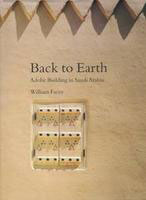
“The lavishly illustrated and well-written book records in great detail an inspirational project that is a major departure from those normally undertaken in Saudi Arabia, or for that matter the Arab world,” writes a review of William Facey’s seemingly rare Back to Earth: Adobe Building in Saudi Arabia
Tallest Earth Buildings
The four tallest earth buildings in the world are:
1. Al-Muhdhar Mosque, Tarim, Yemen – 53 meters (175 feet)
2. Huaca del Sol, Moche, Peru – 41 meters (135 feet)
3. Tower Houses, Shibam, Yemen – 29 meters (96 feet)
4. The Grand Mosque, Djenne, Mali – 11 meters (36 feet)
